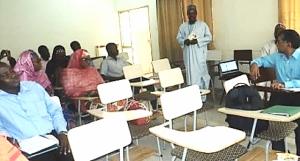Polio Sero-Prevalence Surveys-Confirming Population Immunity as crippling disease disappears.
Abuja, Nigeria 20 November 2014 - By the end of October 2014 Nigeria had recorded tremendous progress with 87% reduction in wild polio virus (WPV1) burden and 78% reduction in geographic spread of the virus. Indigenous transmission of WPV3 has not been reported in the country for 23 months. Also, the genetic clusters circulating in Nigeria have declined from 8 in 2013 to only 1 in 2014 representing 88% reduction.
Acute Flaccid Paralysis (AFP) surveillance is the cornerstone of polio surveillance and is the main ‘compass’ for monitoring progress towards interruption of poliovirus transmission.
To be doubly sure, the disappearance of polio should be backed by evidence of adequate population immunity. Sero-prevalence survey (SPS) is a very important assessment tool to determine population immunity and provide proof to support disappearance of a disease such as polio.
Dr. Kehinde Craig of WHO Nigeria Disease Surveillance Unit gave an insight into the survey during an advocacy visit to the Kano State Commissioner of Health when she said “SPS implies assessment of antibody against the poliovirus serotypes from vulnerable population groups in order to have immunity profiles of such groups as well as to monitor progress towards interruption of poliovirus transmission”.
In Nigeria, SPS studies started in 2011 following an Expert Review Committee (ERC) recommendation. The National Primary Health Care Development Agency (NPHCDA) with the support of World Health Organization (WHO) immediately initiated SPS in Kano State and by 2013, similar studies have been expanded to Sokoto and Kebbi States.
These surveys were carried out within a health facility-based design which had an operational advantage and a fair representation of polio vaccine acceptors and non-acceptors.
The 2011 SPS in Kano was conducted among two age groups; 6-9 and 36-47 months. Sero-prevalence in 6-9 month was found to be 81%, 75%, and 73% for poliovirus types 1, 2 and 3 respectively and 91%, 87%, 85% in 36-47 months. However, the Kano SPS which was repeated in 2013, revealed gaps in population immunity among children 6-9 months of age.
Consequently, the programme modified implementation of its approaches / strategies to attract mothers to bring younger children for outside verifiable immunization at health camps and Directly Observed Polio vaccination points in order to ascertain that children in the younger age cohort receive 2 drops of the oral polio vaccine.
In his appraisal, Dr. Harish Verma, of the WHO HQ Polio Research unit enthused that “the successful conduct of multiple SPS in the northern Nigerian states has provided evidence on immunity levels which has been valuable to adjust IPD operations and assisted managers to focus more on strategies to increase coverage of newborn babies and infants”.
Another important finding from the Polio SPS is the positive correlation between number of OPV doses received and immunity levels: children receiving >7 OPV doses have higher antibody titers of 90% and above, thereby addressing unfounded concerns on ‘too many OPV doses’ often expressed by skeptical health professionals and outright non-compliant parents.
From November - December 2014, WHO will be supporting the conduct of SPS in Katsina State which had the highest WPV burden in 2012 but has not reported any case since the beginning of 2013.
Furthermore, WHO personnel are braving insecurity with plans underway to conduct SPS in Borno and Yobe states based on the need to ascertain the population immunity in these states against all 3 serotypes of the poliovirus, given that the last WPV3 in the country was confirmed two years ago in Yobe state.



